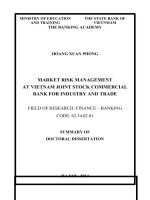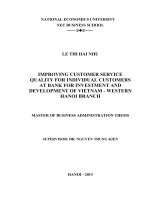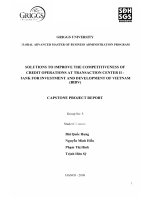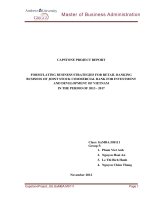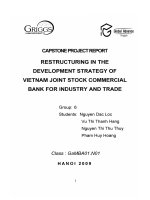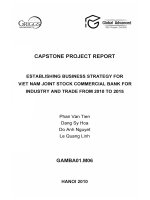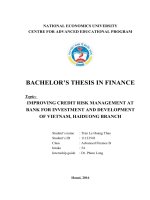Enhancing residential capital mobilization at joint stock commercial bank for investment and development of vietnam transaction office 1
Bạn đang xem bản rút gọn của tài liệu. Xem và tải ngay bản đầy đủ của tài liệu tại đây (1.13 MB, 79 trang )
ĐẠI HỌC QUỐC GIA HÀ NỘI
KHOA QUẢN TRỊ VÀ KINH DOANH
---------------------
ĐỖ NGỌC DŨNG
ENHANCING RESIDENTIAL CAPITAL MOBILIZATION AT
JOINT STOCK COMMERCIAL BANK FOR INVESTMENT AND
DEVELOPMENT OF VIETNAM - TRANSACTION OFFICE 1
TĂNG CƯỜNG HUY ĐỘNG VỐN DÂN CƯ
TẠI NGÂN HÀNG TMCP ĐẦU TƯ VÀ PHÁT TRIỂN
VIỆT NAM - CHI NHÁNH SỞ GIAO DỊCH 1
LUẬN VĂN THẠC SĨ QUẢN TRỊ KINH DOANH
HÀ NỘI - 2018
ĐẠI HỌC QUỐC GIA HÀ NỘI
KHOA QUẢN TRỊ VÀ KINH DOANH
---------------------
ĐỖ NGỌC DŨNG
ENHANCING RESIDENTIAL CAPITAL MOBILIZATION AT
JOINT STOCK COMMERCIAL BANK FOR INVESTMENT AND
DEVELOPMENT OF VIETNAM - TRANSACTION OFFICE 1
TĂNG CƯỜNG HUY ĐỘNG VỐN DÂN CƯ
TẠI NGÂN HÀNG TMCP ĐẦU TƯ VÀ PHÁT TRIỂN
VIỆT NAM - CHI NHÁNH SỞ GIAO DỊCH 1
Chuyên ngành: Quản trị kinh doanh
Mã số: 60 34 01 02
LUẬN VĂN THẠC SĨ QUẢN TRỊ KINH DOANH
NGƯỜI HƯỚNG DẪN KHOA HỌC: TS. PHẠM THỊ THANH HÒA
Hà Nội - 2018
DECLARATION
The author confirms that the research outcome in the thesis is the
result of author’s independent work during study and research period and it is
not yet published in other’s research and article.
The other’s research result and documentation (extraction, table,
figure, formula,and other document) used in the thesis are cited properly and
the permission (if required) is given.
The author is responsible in front of the Thesis Assessment
Committee, Hanoi School of Business and Management, and the laws for
above-mentioned declaration.
ACKNOWLEDGEMENT
I would like to express my deep gratitude to the teachers of the Hanoi
school of Business and Management, Vietnam National University, especially
the teachers who imparted to me a lot of knowledge and helped me. Carry out
this essay.
I would like to express sincere gratitude to Dr. Pham Thi Thanh Hoa
has spent a lot of time, dedicated guidance, only told me during the course
of the topic.
I sincerely thank family, friends and colleagues for encouraging and
supporting me in the process of study and research.
TABLE OF CONTENTS
TABLE OF CONTENTS ..................................................................................................... i
LIST OF TABLES .............................................................................................................. iv
INTRODUCTION................................................................................................................ 1
1. Rationale ................................................................................................................. 1
2. Research overview .................................................................................................. 2
3. Research objectives ................................................................................................. 4
3.1 Overall objective ................................................................................................... 4
3.2 Specific objectives ................................................................................................ 5
4. Research questions .................................................................................................. 5
5. Research object and research scope ........................................................................ 5
6. Research methods.................................................................................................... 5
7. Organization of the thesis........................................................................................ 6
CHAPTER 1: THEORETICAL FaRAMEWORK ON ENHANCING RESIDENTIAL
CAPITAL MOBILIZATION AT COMMERCIAL BANKS .......................................... 7
1.1 Overview of residential capital mobilization activities of commercial banks ...... 7
1.1.1 Basic concepts .................................................................................................... 7
1.1.2 Forms of mobilizing residential capital of commercial banks ........................... 8
1.1.3 Characteristics of residential capital .................................................................. 9
1.1.4 Role of residential capital................................................................................. 10
1.2 Enhancing residential capital mobilization at commercial banks ....................... 11
1.2.1 Concept ............................................................................................................ 11
1.2.2 Contents of enhancing residential capital mobilization at commercial banks . 11
1.2.3 Factors affecting residential capital mobilization at commercial banks .......... 16
1.2.4 Criteria for assessing the effectiveness of residential capital mobilization at
commercial banks ...................................................................................................... 20
i
1.2.5 Experience in enhancing residential capital mobilization at commercial banks
and lessons for BIDV – So GiaoSo Giao Dich 1 Dich 1 Branch .............................. 23
CHAPTER
2:
REALITY
OF
ENHANCING
RESIDENTIAL
CAPITAL
MOBILIZATION AT BIDV - SO GIAO DICH 1 .......................................................... 26
2.1 Introduction of BIDV - So Giao Dich 1 .............................................................. 26
2.1.1 History of foundation and development........................................................... 26
2.1.2 Functions and tasks .......................................................................................... 28
2.1.3 Organizational structure ................................................................................... 29
2.1.4 Business results ................................................................................................ 31
2.2 Reality of enhancing residential capital mobilization at BIDV - So Giao Dich 134
2.2.1 Establishing targets for residential capital mobilization .................................. 34
2.2.2 Building policies to enhance residential capital mobilization ......................... 35
2.2.3 Conducting activities to enhance residential capital mobilization ................... 39
2.2.4 Evaluating the efficiency of residential capital mobilization activities ........... 46
2.3 Evaluation of factors affecting residential capital mobilization at BIDV - So
Giao Dich 1 ............................................................................................................... 50
2.3.1 Subjective factors ............................................................................................. 50
2.3.2 Objective factors .............................................................................................. 55
2.4 General evaluation .............................................................................................. 57
2.4.1 Achievements ................................................................................................... 57
2.4.2 Limitations and causes ..................................................................................... 58
CHAPTER
3:
SOLUTIONS
TO
ENHANCE
RESIDENTIAL
CAPITAL
MOBILIZATION AT BIDV - SO GIAO DICH 1 .......................................................... 61
3.1 Development orientations and objectives of BIDV - So Giao Dich 1 ................ 61
3.1.1 General development orientations ................................................................... 61
3.1.2 Development orientation for enhancing residential capital mobilization ........ 61
3.2 Solutions to enhance residential capital mobilization at BIDV - So Giao Dich 163
3.2.1 Continue to promote marketing and searching for customers ......................... 63
ii
3.2.2 Enhance training to improve the quality of the bank’s staff ............................ 64
3.2.3 Innovate and change banking technology ........................................................ 65
3.2.4 Increase propaganda to change people’s habit of keeping money at home ..... 66
3.2.5 Expand the network of transaction offices ....................................................... 66
3.3 Recommendations ............................................................................................... 67
3.3.1 Recommendations to the State ......................................................................... 67
3.3.2 Recommendations to the State Bank ............................................................... 68
3.3.3 Recommendations to BIDV ............................................................................. 68
CONCLUSION .................................................................................................................. 70
REFERENCES ................................................................................................................... 71
iii
LIST OF TABLES
Table 2.1: Business results of BIDV - So Giao Dich 1.................................................... 32
Table 2.2: Targets for residential capital mobilization of BIDV - So Giao Dich 1 ....... 34
Table 2.3: Individual customer policy of BIDV ............................................................... 35
Table 2.4: Diversification and innovation of residential capital mobilization products at
BIDV – So Giao Dich 1 ..................................................................................................... 37
Table 2.5: Interest rates for capital mobilization of BIDV compared to other
commercial banks in Hanoi on 31 December, 2016 ........................................................ 39
Table 2.6: Expenses for the propaganda and promotion of residential capital
mobilization products ......................................................................................................... 41
Table 2.7: Promotion activities for residential customers using residential capital
mobilization products ......................................................................................................... 42
Table 2.8: Amounts of promotion gifts in the program "Golden Gift of October" at
BIDV – So Giao Dich 1 ..................................................................................................... 44
Table 2.9: Contents of the training of residential capital mobilization staff................... 45
Table 2.10: Structure of residential capital mobilization at BIDV – So Giao Dich 1 .... 46
Table 2.11: Structure of types of residential capital at BIDV – So Giao Dich 1............ 47
Table 2.12: Market share of residential capital mobilization of some commercial banks
in Hanoi ............................................................................................................................... 48
Table 2.13: Expenses for residential capital mobilization at BIDV – So Giao Dich 1 .. 50
Table 2.14: Marketing activities to enhance residential capital mobilization at BIDV –
So Giao Dich 1.................................................................................................................... 51
Table 2.15: Reality of human resources in capital mobilization at BIDV – So Giao
Dich 1 .................................................................................................................................. 53
iv
INTRODUCTION
1. Rationale
The process of economic integration in the region and the world is taking
place very excitingly. When the TPP agreement comes into effect in 2018, Vietnam
will have more opportunities to approach world markets and developed economies.
This also means that the competition will be fiercer in the whole economy. At the
same time, our country is in the period of dramatic economic changes - the period
of accelerating industrialization and modernization of the country - helping the
country through underdevelopment and improving the quality of life. In order to
successfully execute that strategy, the demand for capitals is very huge and urgent.
Therefore, current banks are constantly improving their service quality, expanding
their operation network, and modernizing their systems in order to attract more
capitals. In which, the capital mobilized from residents is being paid special
attention by commercial banks since the potential capital in the population is great
but not yet exploited and people have not been aware of the profitability of deposits
in banks, together with many other objective reasons.
As one of the largest commercial banks in Vietnam, Joint Stock Commercial
Bank for Investment and Development of Vietnam (BIDV) in general and So Giao
Dich 1 in particular are actively implementing many measures to mobilize the
maximum capital from residents in order to finance the projects of socio-economic
investment and development, serving effectively for the industrialization and
modernization of the country. Accordingly, the branch has carried out many
advertising activities such as advertising on radio channels, social networks,
hanging posters and banners, etc. Some promotional programs deployed branches
by the bank such as "Getting Gold with BIDV", "Double Lucks – Multiple
Happiness", "Soon Deposit - Big Presents" have been enthusiastically supported by
customers in the area. However, due to the general difficulties of the economy and
the fierce competition among banks in the area, the mobilization of capitals from
1
residents has somehow grown but there has been no breakthrough in terms of size
and capital quality.
In addition to the achievements, the capital mobilization activities of the
branch also faced some difficulties such asthelow income level of people in the
area, the little accumulation of money in the population, the fierce competition
among other credit institutions in the area, leading to the low efficiency of the
branch’s capital mobilization.
Based on the above reality, in order to help the Board of Directors of Vietnam
Joint Stock Commercial Bank for Investment and Development clearly understand the
successes as well as the shortcomings in the mobilization of residential capital at the
branch in the past few years and have a basis for carrying out the residential capital
mobilization, the author selected the topic "Enhancing residential capital
mobilization at Joint Stock Commercial Bank for Investment and Development of
Vietnam–So Giao dich 1 Branch" as his thesis topic.
2. Research overview
A bank is an organization that plays an important role in the economy.
Traditional banking services includelending, foreign exchange trading, trade financing,
providing transaction accounts, and so on. With the traditional model, offering loans is
considered a highly profitable activity, so banks have proposed many solutions to
mobilize the sources of loan capital. In addition to the capital from foreign credit
institutions, one of the important sources of capital is the capital mobilized from
residents in domestic market. However, how to mobilize residential capitals effectively
is the question that banks need to consider so that they can find out solutions to expand
and enhance the efficiency of residential capital mobilization. Therefore, this topic has
been concerned by many scholars and managers.
A scientific research was conducted by Dinh Thuy Kim Hoang (2011) entitled
"Solutions to enhance mobilization of savings deposits at Eximbank - Dong Nai
Branch". In the study, the author administered survey questionnaires to 100 customers
in Dong Nai Province and then used SPSS software to process the data. With a
combination of many research methods including statistics, investigation, comparison,
2
analysis, synthesis, and so on, Dinh Thuy Kim Hoang triggered the reality of capital
mobilization in the form of savings deposits at Eximbank and proposed feasible
solutions to expand and enhance the efficiency of capital mobilization at Eximbank.
The study was carried out in the period of time when the economy was facing high
inflation, so the research results made important contributionin helping the
management of Eximbank deploy solutions to promote the efficiency of residential
capital mobilization. However, due to the small sample size and the large scope of the
research, the results of the survey were not representative.
Nguyen Ngoc Phuong (2008) carried out a study on "Some solutions to
enhance residential capital mobilization at Vietcombank - Ba Dinh branch". With a
combination of various methods such as dialectical materialism methods, statistics,
comparison, etc., the author systematized and clarified the basis of the theoretical
framework on capital mobilization and confirmed the role of capital mobilization in
business operations of the bank. At the same time, the reality of mobilizing capitals
at Vietcombank - Ba Dinh branch (mainly in VND) was also evaluated. From that,
the research provided solutions and recommendations to improve the efficiency of
capital mobilization at the branch. The research was of high practical value;
however, the contents of the research mainly focused on capital mobilization but did
not present the contents as well as the factors affecting the mobilization of
residential capitals of Vietcombank.
Another research conducted by Nguyen Hoa Nhan (2013) was about
"Extending residential capital mobilization at BIDV - Nam Ha Noi Branch". The
study synthesized basic theoretical issues on capitals, especially the mobilization of
residential capitals of commercial banks. Based on the criteria reflecting the
enhancement of residential capital mobilization, the author conducted an analysis
and assessment of the reality of residential capital mobilization at BIDV – Nam Ha
Noi Branch and looked for solutions to expand the residential capital mobilization
at BIDV – Nam Ha Noi branch. The study made feasible recommendations that
were in line with the business situation of the branch, helping the branch promote
the efficiency of capital mobilization, especially from residents. However, the study
3
had not mentioned the factors affecting the expansion and increase of residential
capital mobilization of commercial banks in general, and of BIDV – Nam Ha Noi
Branch in particular.
Omankhalen (2015) conducted a study entitled "The Role of Banks in Capital
Formation and Economic Growth: The Case of Nigeria." In this study, the author mainly
examined the relationship between bank mobilization and internal economic growth in
Nigeria. At the same time, the author also analyzed the reality of capital mobilization at
commercial banks in Nigeria and proposed solutions to improve the efficiency of this
work. The study supplemented the literature demonstrating the positive relationship
between bank capital mobilization and economic growth. However, the study just
generally mentioned capital mobilization without further analyzing and evaluating the
sources of capitals mobilized from residents.
The research of Chris Humephery Rumenda, Joash Simiyu Wakoli, and Winnie
Wanjiru Nyantika (2012) was about the "Factors influencing savings mobilization by
commercial banks: A case study of commercial banks in Nakuru". The study focused on
assessing the mobilization of savings from residents of commercial banks in Nakuru, and
particularly studied the factors affecting the mobilization of savings deposits at the banks.
By testing the impact of each factor, the author made suggestions and recommendations
to help commercial banks in Nakuru improve the efficiency of mobilizing savings
deposits from residential areas.
It can be realized that each of the studies above had a particular approach
that suited the research objectives of each topic, but there had been no
comprehensive research on the enhancement of capitalmobilization from residential
areas. Therefore, in order to complete and fill the gap of previous studies, the author
carried out the topic of enhancing residential capital mobilization at commercial
banks and selected BIDV - So Giao Dich 1 as a case study.
3. Research objectives
3.1 Overall objective
The research aims at studying and evaluating the strengths and weaknesses
of the mobilization of residential capital in the last period, from which
4
proposingmeasures to increase residential capital mobilization at BIDV – So Giao
Dich 1in the coming time.
3.2 Specific objectives
- Systematizing and synthesizing the theoretical framework on enhancing
residential capital mobilization at commercial banks.
- Analyzing the reality of enhancing residential capital mobilization at BIDV
- So Giao Dich 1.
- Proposing solutions to enhance residential capital mobilization at BIDV So Giao Dich 1.
4. Research questions
What is the reality of enhancing residential capital mobilization at BIDV - So
Giao Dich 1?
What are the solutions to enhance residential capital mobilization at BIDV So Giao Dich 1?
5. Research object and research scope
Research object
The object of the study was the enhancement of residential capital
mobilization at BIDV - So Giao Dich 1 and solutions for implementation in the
current stage.
Research scope
- In terms of space: The study was conducted at BIDV - So Giao Dich 1.
- In terms of time: The research data were collected in the stage of 20142016 at BIDV – So Giao Dich 1.
6. Research methods
Research using the following methods:
+ Comprehensive Analytical Methods: Based on the collected data and materials,
the author will conduct analytical and critical review and selection of critical material and
will undertake thesis analysis. The author used this method to analyze the efficiency of
business results, Targets for residential capital mobilization of BIDV - So
Giao Dich 1, Interest rates for capital mobilization of BIDV compared to other
5
commercial banks in Hanoi on 31 December, 2016; Expenses for the propaganda
and promotion of residential capital mobilization products,…
+ Comparative method: The comparison method is used to compare change of
indicators reflecting the efficiency of enhancing residential capital mobilization at BIDV –
So Giao Dich 1 branch
7. Organization of the thesis
The thesis consists of the following three main chapters:
Chapter 1: Theoretical framework on enhancing residential capital
mobilization at commercial banks.
Chapter 2: Reality of enhancing residential capital mobilization at BIDV - So
Giao Dich 1.
Chapter 3: Solutions to enhance residential capital mobilization at BIDV - So
Giao Dich 1.
6
CHAPTER 1: THEORETICAL FRAMEWORK ON ENHANCING
RESIDENTIAL CAPITAL MOBILIZATION AT COMMERCIAL BANKS
1.1 Overview of residential capital mobilization activities of commercial banks
1.1.1 Basic concepts
Commercial bank
Commercial banks have existed and developed for hundreds of years
associated with the development of the commodity economy. The development of
the commercial bank system has had a great impact on the development of the
commodity economy. In the market economy, commercial banks have been
improved and become indispensable financial institutions. Despite the long history
of development, the introduction of a specific concept of commercial banks remains
controversial for economists. There are different concepts at different times:
According to the world economists,a commercial bank is a type of business
operating and trading in the monetary and credit sectors.A commercial bank is a
type of financial institution which provides the most diversified portfolio of
financial services, especially savings, payment services and performs more financial
functions than any other organizations in the economy.
According to the Law on Credit Institutions in Vietnam, "A commercial bank
is a credit institution which is entitled to carry out all monetary operations, perform
banking functions and other related activities", in which "Banking activities include
monetary trading and banking services with regular contents of receiving deposits,
using deposits to offer credit and provide payment services" (Law on Credit
Institutions, 2010).
Thus, commercial banks are one of the financial institutions specializing in
providing a variety of financial services with the basic operations of receiving
deposits, lending and providing payment services. In addition, commercial banks
also provide other services to satisfy the maximum demand for products and
services of the society.
Capital mobilization
7
Capital mobilization is an activity that creates capital for commercial banks,
which plays an important role and affects the quality of banking operations. This
activity provides banks with capital to carry out other activities such as granting
credit and providing banking services to customers. The capital mobilization
activities of the banks are reflected in the debit assets.
According to the Law on Credit Institutions (2010) in Vietnam, commercial
banks are allowed to mobilize capital in the following forms:
- Receiving deposits from organizations, individuals and other credit
institutions in the forms of demand deposits, time deposits and other types of
deposits.
- Issuing certificates of deposit, bonds and other valuable papers to mobilize
capital of domestic and foreign organizations and individuals when permitted by the
Governor of the State Bank.
- Borrowing capital from other credit institutions operating in Vietnam and
foreign credit institutions.
- Borrowing short-term capital from the State Bank in accordance with the
Law of the State Bank of Vietnam.
Residential capital mobilization
Residential capital mobilization (i.e. mobilizing deposits from residents) is
the activity that banks implement to mobilize capital from residents, agents with
payment accounts, time deposits or valuable papers issued by the banks (Nguyen
Van Tan, 2016).
According to Che Thi Thanh Nguyet (2012), the activity of mobilizing
residential capital of commercial banks is one of the major and important activities
of commercial banks. This activity generates capital for commercial banks in
various forms such as receiving demand deposits, time deposits and issuing debt
recovery instruments to attract idle funds from all classes of population.
1.1.2 Forms of mobilizing residential capital of commercial banks
Commercial banks can mobilize residential capital from in the following
forms:
8
- Opening payment accounts for individuals: Payment deposits includepayment
deposits with interest and payment deposits without interest. This is the most volatile
capital and it is difficult to predict the size of deposits. The interest paid to this account
balance is the lowest, so the cost of capital mobilization is very low.
- Mobilizing time deposits fromresidents: This type of deposit is an agreement
between the bank and the customer about the time of depositing and is a source of
intermediate deposit between payment deposit and savings deposit. Time deposits
usually have long maturities and high interest rates, so they are relatively stable.
- Mobilizing savings deposits from residents: Savings deposits are created to
attract the capital of those who wish to put aside some money for specific goalsor
financial needs in the future. The interest rates applied for this type of deposit are
much lower than for demand savings deposits.
- Mobilizing by issuing valuable papers: This is the form of mobilization in
which banks mobilizing monetary capital by issuing valuable certificates, including
certificates of deposit, promissory notes and bonds. Certificates of deposit are shortterm debt notes with specified par value.Bonds are medium and long-term
debtnotes. Promissory notes are short-term valuable papers (in one year). They have
the same characteristics as bonds but have a shorter term than bonds, so they are
used for the purpose of short-term capital mobilization of banks. These types of
debt notes are issued by banks on a case-by-case basis.
1.1.3 Characteristics of residential capital
+ Residential capital often hasshort terms.
Residential
capital
include
residents'
payment
deposits,which
are
consumption or business payments and are usually transferred from one account to
another, from a bank to another bank or withdrawn for the purpose of spending. As
a result, this type money stays in the customers' accounts in a very short time.
+ Residential capital is more stable than capital mobilized from economic
organizations.
Due to the large number of individual customers and the smaller amounts of
deposits than those of organizations, the fact that an individual customer
9
withdrawsmoneyhas less impacton the total mobilized capital thanthe fact that a
corporate customer withdraws money.
In addition, residents usually put their money into commercial banks for
savings (time deposits). With this form, customers will agree with the banks on
terms and interest rates. In necessary cases, customers can still withdraw money
before maturity.However, the majority of customers can determine their deposit
terms and only withdraw their money at maturity or continue to keep their money in
the banks. Therefore, the residential capital has high stability. Based on this
characteristic, commercial banks can use the residential capital for medium and
long-term loans. This is an advantage of the residential capital.
+ The expenses for residential capital mobilization are high.
Due to the stability and the profitability purpose of customers, the
expensesfor mobilizing residential capital are normally high. Theseexpenses include
interest expenses and non-interest expenses. Interest expensesare the interest
payablesto types of deposits in accordance with the deposit interest rates agreed by
the banks and the customers. Non-interest expenses are diversified, including
expenses directly paid to depositors such as gifts, insurance, expenses for paying
salaries tothe bank staff, and expenses for increasing utilities for depositors such as
opening more branches, transaction offices, and so on.
1.1.4 Role of residential capital
The development of residential capital mobilization brings benefits not only
to commercial banks but also to the society and residential customers:
For the society:The mobilization of residential capital of commercial banks
is used to supplement capital for the economy and raise the living standard of
people instead of using the capital for other expenditures. Thanks to the savings,
people have increased their production and business activities, created more jobs for
laborers and raised their living standard through the indirect benefits of the savings
capital. The larger the residential capital is, the more benefits it brings to the
society. This capital will benefit both the banks and the people, and the State will
reduce an investment in the economy. In addition, the mobilization of residential
10
capital will contribute to developing personal payment deposits, boosting non-cash
payment and saving the costs for issuing and circulating cash in the economy.
For residential customers: Customers who participate in the activity of
capital mobilization of commercial banks will have income from the amount of
money they deposit into the bank. Using capital mobilization products of the banks,
customers are guaranteed capital security, enjoy interest and, most importantly, can
use fast and convenient payment services.
For banks:Residential capital is important to the banks and is the major
object that the banks aim at to maintain in the long-term and sustainable
development. Mobilization of residential capital is not only of great social
significance, but also of great significance for the banks themselves.
The more residential capital is mobilized, the stronger the banks’ financial
capacity is. Residents are not only the objectsfor capital mobilization of commercial
banks but also their customers. When there is idle money, a number of people will
deposit it into banks. Meanwhile,otherswho have the opportunity to do business but do
not have capital will come to banks to apply for loans. Thus, the mobilization of
residential capital of commercial banks benefit both people and the banks themselves,
contributing to raising the efficiency of capital use for the society.
1.2 Enhancing residential capital mobilization at commercial banks
1.2.1 Concept
Enhancing residential capital mobilization at commercial banks refers to the
activities carried out by commercial banks to increase the volume of deposits from
residential customers,expand the size of mobilized capital with suitable deposit
structure and reasonable mobilization expenses to meet the banks' demand for
capital, increase the market share of residential capital mobilization andenhance the
quality of capital mobilization service.
1.2.2 Contents of enhancing residential capital mobilization at commercial banks
1.2.2.1 Establishing targets for residential capital mobilization
+ Looking for cheap sources of capital
Interest expense is considered the largest expense of a bank in the
mobilization of residential capital. In which, the largestexpenseis for paying
11
interests for time deposits. Normally, there are three ways of paying interests for
residential capital including: interests paid in advance, interests paid at maturity and
interests paid periodically.
Of the types of residential capital, payment deposits are the one with the least
costssince banks must provide some utility services for this kind of mobilized
capital, and they can be sent and withdrawn at any time. Therefore, this is the
source of residential capital that commercial banks need to increase.
+ Creating stable sources of capital and appropriate structure
The structure of residential capital should be diversified by maintaining a
ratio between short-term and long-term deposits, between local currency and
foreign currency. A bank with high quality of residential capital will have abundant
sources of capital and a balanced capital structure, which help the banks avoid
financial stress in the changing business environment.
The change in the structure of residential capital depends partly on banks'
adjustment plans and external factors which require the banks to regularly research
and approach the market to determine the suitable structure of residential capital for
their banking activities.
+ Developing stable sources of capital.
A bank which wants to expand its operations needs a large volume of capital, in
which residential capital is an important part. The volume of residential capital must
reach a certain scale according to the mobilization plan of the bank. In order to properly
implement this issue, it is necessary to harmonize other factors such as interest rates,
marketing policies, forms of capital mobilization and prestige of banks.
1.2.2.2Developing policies to enhance residential capital mobilization
The policy of mobilizing residential capital of commercial banks is one of
the decisive factors for the success of the enhancement of residential capital
mobilization. In each period, the demand for capital of a bank is different. The
policy to enhancethe mobilization of residential capital includes the following
contents:
- Customer policy
12
Customer policy includes all contents related to business activities which aim
at approaching customers of banks. The success or failure of a bank is determined
by its ability to attract customers to use its capital mobilization products. Through
the customer policy in each period, the bank can use appropriate methods and
measures to attract customers without affectingcustomers’ trust and expectations
towards the bank.
- Interest rate policy
Interest ratesare the prices of loans. When mobilizing capital, banks always
expect deposit interest rates to be low so that the costs for mobilization are cheap. In
contrast, customers depositing at banks always want high interest rates.
With different types of residential capital mobilization, banks offer different
interest rates, such as low interest rates for payment deposits, but high interest rates
for savings deposits. In the same method of mobilization, but interest rates are
different for different terms. The longer the terms are, the higher the interest rates
are. Moreover, banks often have to ensure a positive real interest rate to attract
savings depositors.
Therefore, when carrying out the mobilization of residential capital,
commercial banks should consider changing interest rates so that customers feel
they are beneficial and satisfied. As a result, the residential capital of commercial
banks will be increased.
- Product policy
The products of residential capital mobilization of commercial banks are
diversified and can be classified as follows:
+ Based on terms, residential capital mobilization products can be divided
into short-term, medium-term and long-term capital.
Short-term capital: is the capitalwith a term of less than 12 months.
Medium-term capital: is the capital with a term of 12 months to less than 60
months.
Long-term capital: is the capital with a term of more than 60 months.
13
+ Based on the methods of mobilization, it is possible to divide residential
capital mobilization into deposit mobilization, loan mobilization andissuance of
valuable papers.
+ Based on types of currency, residential capital mobilization is divided into
local currency mobilization and foreign currency mobilization.
1.2.2.3Conducting activities to enhance residential capital mobilization
In order to enhanceresidential capital mobilization, commercial banks can
carry out the following activities:
Establishing a network of transaction points
The larger the operation network is andthe more diversified the forms of
mobilizationare, the more effective the capital mobilization will be in terms of
quantity and quality.
Through the operations and survey of the real situation, customers are not only
interested in interest rates, utility services of banks when providing residential capital
mobilization products but also pay attention to the convenience of money deposit.
Therefore, it is necessary to create convenience for residential customers in order to fully
mobilize the idle money from residents and compete with other credit institutions.
Strengthening propaganda and advertising activities
In today's strongly competitive environment, it is difficult to maintain the
product differentiation and pricing, so advertising and serving strategies are crucial
to attracting customers to use capital mobilization products of commercial banks.
Friendly and thoughtful attitude is a condition to attract customers. Besides, suitable
advertising strategies will help banks have many new customers. Therefore, in order
to have prestige in the market tomaintain the relationship with traditional customers
and attract more new customers, banks must constantly improve the quality of their
services and have a reasonable advertising strategy so that more peoplewill know
aboutthe banks and their residential capital mobilization products.
Strengthening promotion activities
Promotions are activities that go along with advertising. In the mobilization
of residential capital of commercial banks, the promotion programscan beappliedas
follows:
14
- Encourage customers to use new services and new distribution
methods;improverelationships with loyal customers.
- Show preferential treatment to loyal customers.
- Increase customers’ attention at the time of fierce competition. Banks often
use forms of promotion in the capital mobilization such asoffering gifts, organizing
customer conferences, spinning wheels for prizes, giving materials, etc.
Promoting staff training
Human resources are also one of the factors that enhance commercial banks'
residential capital mobilization. A bank with a team of skillful, friendly, dynamic
staffand a reasonable organization meeting the requirements of business
development will have advantages in the mobilization of residential capital and vice
versa.
1.2.2.4Evaluating efficiency of residential capital mobilization activities
To evaluate the efficiency of residential capital mobilization activities of
commercial banks, managers can use the following indicators:
+ The growth of residential capital volume
The growth rate of residential capital volume of a bank is the indicator
reflecting the scale of residential capital mobilization that bank, which is evaluated
by the increase in residential deposit balance at each time and in each period of the
bank.
+ The structure of residential capital
The structure of residential capital must be derived from the plan of capital
use in terms of terms, portfolio, amount of foreign currency, loan interests, etc. in
order to have the most effective mobilization strategy. Based on that, banks will
build a reasonable residential capital structure.
+ The growth of market share of residential capital
This indicator shows commercial banks’ ability to mobilize residential
capital compared to their competitors and helps commercial banks to assess the
results of their capital mobilization.
+ Expenses for mobilizing residential capital resources
15
The expenses forresidential capital mobilization a bank include interest
expenses and other expenses. This indicator shows how much money is needed to
mobilize anamount of capital.
+ Quality of residential capital mobilization services
For commercial banks, an important way to increase competitiveness as well
as increase sources of residential capital is to improve the quality of mobilization
products. This has a significant impact on attracting customersto usethe products
and services of the banks.
1.2.3 Factors affecting residential capital mobilization at commercial banks
1.2.3.1 Subjective factors
Marketing activities
In order to enhance the residential capital, good products are not enough.
Commercial banks need to carry out marketing activities so that customers can
understand the advantages and benefits of the product.
The basic elements of banking marketing activities are public relations,
market research, organization and management of banking services, prices of
banking services (in capital mobilization, prices are understood as interest rates),
promotional activities and service delivery activities. These factors have a strong,
close relationship with each other. The completion of this factor a prerequisite for
implementing the others and ultimately achieving the goal of developing and
offering different types of serviceswithhigh quality and utilities which satisfy the
needs of customers.
Thus, marketing activities play an important role in the operations of the
banks in general and the mobilization of residential capital in particular,
contributing to attracting customers and increasing the business efficiency of the
banks.
Quality of human resources
In terms of management
Banks need to manage their human resources, assets and liabilities well. In
the course of its business operations, banks should be able to anticipate the risks and
16
predict whether the investment environment is effective and promptly capture the
changes in the market to be able to advise their customers most effectively. This
will attract customers and expand the banks’ investment environment. Moreover, if
the management is good, banks will ensure the safety of capital, increase prestige,
and thereby expand the deposit customers.
In terms of professional competence
If the professional competence of the bank staff is good, the process of
operationswill be carried out quickly, accurately and effectively.From this,bankswill
have conditions to expand business and attract more customers to use their
residential capital mobilization products.
In terms of serving attitude
Service attitude is a subjective factor affecting the size of residential capital
at commercial banks. If a bank operates well witha team ofopen, enthusiasticbank
staffthat always create favorable for customers in the transactions will create a good
reputation for customers. As a result, the bank willbe able to attractmore residential
customers to use capital mobilization products and the volume of residential capital
of commercial banks will be increased.
Technology level of the banks
Since banking products and services are intangible and can only be felt in the
process of using products and services. Therefore, customers are forced to search
for banks with good quality products with good brand name, transaction locations,
level of technological equipment, prestige, and so on.
Banking facilities and technology are factors that directly influence the
expansion and enhancement of service quality and residential capital of commercial
banks. Technology will create customers’ satisfaction thanks to products of
residential capital mobilization with good quality, shortened transaction time, safety
and security. For commercial banks, modern technology will create a breakthrough
in exploiting residential capital mobilization products and services in both quantity
and quality, indirectly affirming the image of the banks. In terms of management,
thanks to technology, the internal management in the banks will be more effective;
17

